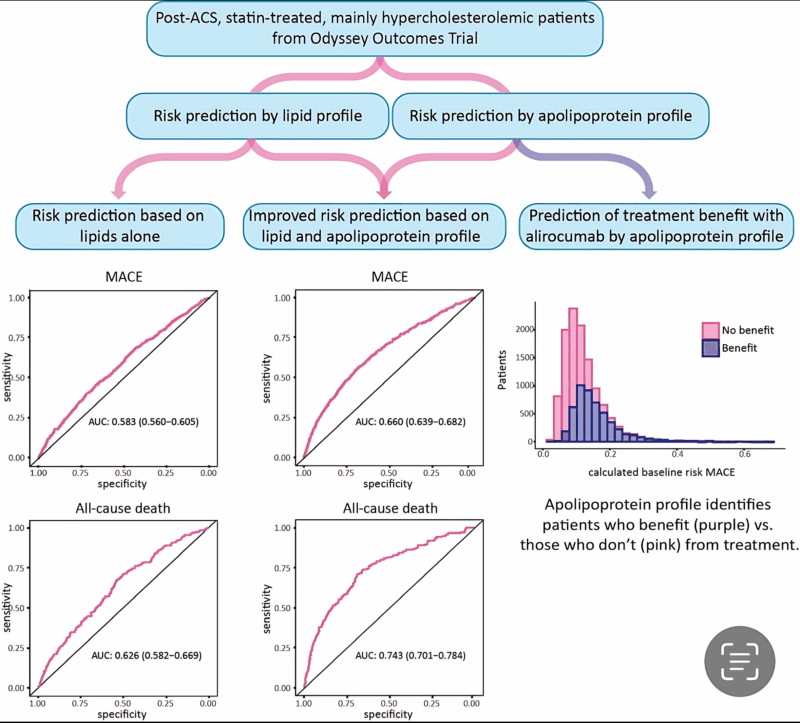
Multiplex Apolipoprotein Panel Boosts Cardiovascular Risk Prediction and Precision Therapy
Pablo Corral, Pharmacology Professor at FASTA University, Past President of Argentine Lipid Society, posted on LinkedIn:
”New in ATVB (Nov 2025)
Multiplex Apolipoprotein Panel Boosts Cardiovascular Risk Prediction and Precision Therapy
In >11,800 post-ACS patients from ODYSSEY OUTCOMES, a 9-plex mass-spectrometry apolipoprotein panel outperformed the standard lipid profile in predicting:
• Major adverse cardiovascular events (MACE) (AUC 0.65 vs 0.58)
• All-cause death (AUC 0.70 vs 0.60)
The panel also identified which patients benefit most from PCSK9 inhibition (alirocumab) – paving the way for precision lipidology.
Key components: Apo(a), ApoA-I, ApoA-II, ApoA-IV, ApoB, ApoC-I, ApoC-II, ApoC-III, ApoE.
Alirocumab reduced Apo(a), ApoB, and ApoC isoforms by >30–50%.
Bottom line:
Integrated apolipoprotein profiling refines risk stratification and optimizes treatment allocation – a step forward in personalized cardiovascular medicine.
Open Access”
Title: Multiplex Apolipoprotein Panel Improves Cardiovascular Event Prediction and Cardiovascular Outcome by Identifying Patients Who Benefit From Targeted PCSK9 Inhibitor Therapy
Authors: Esther Reijnders, Patrick M. Bossuyt, J. Wouter Jukema, L. Renee Ruhaak, Fred P.H.T.M. Romijn, Michael Szarek, Stella Trompet, Deepak L. Bhatt, Vera A. Bittner, Rafael Diaz, Sergio Fazio, Irena Stevanovic, Shaun G. Goodman, Robert A. Harrington, Harvey D. White, Philippe Gabriel Steg, Gregory G. Schwartz, Christa M. Cobb

Stay informed with Hemostasis Today.
-
Nov 4, 2025, 09:26Courtney Lawrence: One of Our Most Popular American Red Cross SUCCESS Talks is Just Around the Corner!
-
Nov 4, 2025, 09:21New Study by Emmanuel J Favaloro and Team Questions Consistency in APS Classification and Diagnosis
-
Nov 4, 2025, 09:20Yazan Abou Ismail to Present Insights on AI Models in TTP at 67th ASH Annual Meeting
-
Nov 4, 2025, 09:17David Calvet Canut on Takeda's HyHub: A Shift Toward Patient-Centered Biologics
-
Nov 4, 2025, 09:16Samantha Nelson Encourages You to Share Your Experience on World Thrombosis Day
-
Nov 4, 2025, 08:57Toluwalase Awoyemi: Digital Health Meets Maternal Heart Care
-
Nov 4, 2025, 08:53Rebecca Ahrens Nicklas Shares FDA Interactions on Interventional Genetics with The Rare Disease Community
-
Nov 3, 2025, 09:13Claudio Carrubba on How Timing Truly Matters in Trauma Embolization
-
Nov 3, 2025, 08:57Multiplex Apolipoprotein Panel Boosts Cardiovascular Risk Prediction and Precision Therapy
-
Nov 3, 2025, 08:46Rachel Lamerton and Colleagues on Activation of Platelets in Flow Cytometry
-
Nov 4, 2025, 09:10OCCUPI Trial Analysis Highlights Benefits of OCT Guidance in ACS Patients
-
Oct 29, 2025, 07:31The Use of Artificial Intelligence to Improve Detection of Acute Incidental Pulmonary Emboli - JTH
-
Oct 29, 2025, 07:05Shrinidhi Nathany: AI in Diagnostic Medicine
-
Oct 28, 2025, 07:02Aya Berman: AI Model for Predicting Bacteremia
-
Oct 28, 2025, 06:55The New Era of Genomics, AI and Cell Therapy in Hematology and Infectious Diseases
-
Nov 4, 2025, 09:17HaemophiliaIRL Series Begins․ Advances in von Willebrand Disease Treatment
-
Nov 4, 2025, 09:14Exploring Molecular Pathways of Aging in Hematopoiesis․ FEBS Workshop 2025
-
Nov 4, 2025, 08:28Fritz Roth Thanks Supporters of Science Magazine Study Linking Genes to High Cholesterol and Heart Attack Risk
-
Nov 4, 2025, 08:22Colleen Silk on Novo Nordisk Taking the 2025 Prix Galien US Award
-
Nov 4, 2025, 08:14Cristina Anton: Excited to Be Part of Women in Hematology!
